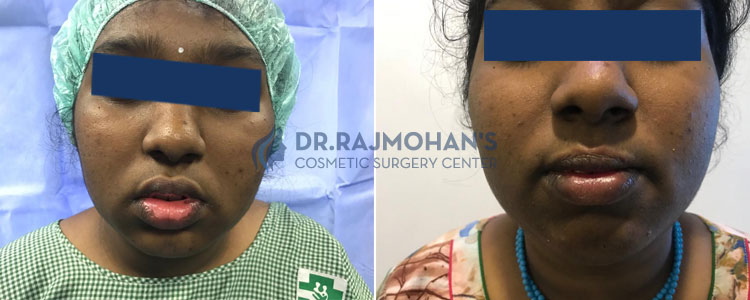- Call: 9940436649 / 9791112455
- Email us: admin@drrajmohan.com
Vitiligo / Leucoderma

Vitiligo / Leucoderma
Vitiligo is a pigmentation disorder in which melanocytes (the cells that make pigment) in the skin are destroyed. As a result, white patches appear on the skin in different parts of the body. Similar patches also appear on both the mucous membranes (tissues that line the inside of the mouth and nose) and the retina (inner layer of the eyeball). The hair that grows on areas affected by vitiligo sometimes turns white.
Vitiligo generally appears in one of three patterns :
focal pattern — depigmentation limited to one or only a few areas
segmental pattern — depigmented patches that develop on one side of the body
generalized pattern — the most common pattern. Depigmentation occurs symmetrically on both sides of the body
In addition to white patches on the skin, people with vitiligo may have premature graying of the scalp hair, eyelashes, eyebrows, and beard. People with dark skin may notice a loss of color inside their mouths.
Treatment
The main goal of treating vitiligo is to improve appearance. Therapy for vitiligo takes a long time-it usually must be continued for 6 to 18 months. The choice of therapy depends on the number of white patches; their location, sizes, and how widespread they are; and what you prefer in terms of treatment. Each patient responds differently to therapy, and a particular treatment may not work for everyone. Current treatment options for vitiligo include medication, surgery, and adjunctive therapies (used along with surgical or medical treatments). Surgical therapies
All surgical therapies must be considered only after proper medical therapy is provided. They are appropriate only for carefully selected patients who have vitiligo that has been stable for at least 3 years
• Autologous skin grafts. The doctor removes skin from one area of your body and attaches it to another area. This type of skin grafting is sometimes used for patients with small patches of vitiligo. The doctor removes sections of the normal, pigmented skin (donor sites) and places them on the depigmented areas (recipient sites).
• Skin grafts using blisters. In this procedure, the doctor creates blisters on your pigmented skin by using heat, suction, or freezing cold. The tops of the blisters are then cut out and transplanted to a depigmented skin area.
• Micropigmentation (tattooing). This procedure involves implanting pigment into the skin with a special surgical instrument. It works best for the lip area, particularly in people with dark skin. However, it is difficult for the doctor to match perfectly the color of the skin of the surrounding area.
Medical therapies
A number of medical therapies, most of which are applied topically, can reduce the appearance of vitiligo. These are some of the most commonly used:
• Topical steroid therapy. Steroid creams may be helpful in repigmenting (returning the color to) white patches, particularly if they are applied in the initial stages of the disease.
• Psoralen photochemotherapy. Also known as psoralen and ultraviolet A therapy (PUVA) therapy, this is probably the most effective treatment for vitiligo available in the United States. The goal of PUVA therapy is to repigment the white patches.
o Topical psoralen photochemotherapy. Often used for people with a small number of depigmented patches affecting a limited part of the body and for children age 2 and older who have localized patches of vitiligo.
Dermabrasion
Dermabrasion is a technique that uses a wire brush or a diamond wheel with rough edges (called a burr or fraise) to remove the upper layers of the skin. The brush or burr rotates rapidly, taking off and leveling (abrading or planing) the top layers of the skin. This process injures or wounds the skin and causes it to bleed. As the wound heals, new skin grows to replace the damaged skin that was removed during dermabrasion.
Your recovery and healing time after dermabrasion depends on the size and depth of the area that was treated. Deeper abrasions take longer to heal. In general, regrowth of skin occurs within 5 to 8 days. This new skin is a pink or red color, which usually fades within 6 to 12 weeks. Until then, your normal skin tones can be achieved using makeup.
Proper care of the treated area while the skin is healing is extremely important. This involves:
• Cleansing the skin several times a day to avoid infection and to get rid of the crusting that sometimes develops.
• Changing the ointment or dressing on the wound to keep the area moist and to promote healing.
• Avoiding sun exposure and, after peeling has stopped, using sunscreen every day. New skin is more susceptible to sun damage.

